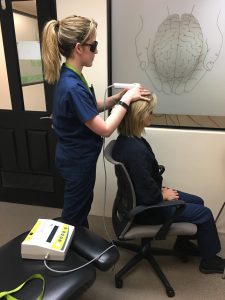Donna Fisher, an internationally best selling author, has written a book that describes a combination of ground-breaking new technologies that are being used to treat many conditions that previously had very little hope of cure or relief. Her book is a drugfree encyclopaedia to assist in achieving and maintaining vitality and health naturally.
One of the most promising technologies discussed in the book has shown promise in the treatment of neurodegeneration, depression, Parkinson’s disease and in enhancing brain function itself. This therapy is called noninvasive transcranial laser therapy (tLLLT). Dr Randy Beck, Executive director of the Institute of Functional Neuroscience, explained how the process works, ”This therapy promotes neuroprotection by stimulating mitochondrial function, thereby increasing cellular energy production. This neuroprotective activity is produced as a result of an energy conversion process known as photobiostimulation”.
Photobiostimulation or photobiomodulation is the process that occurs when light of a certain wavelength strikes light receptive components of molecules in the brain. Photobiostimulation directly affects cellular metabolic activity that is regulated by energy production within mitochondria that are living inside of the neurons in your brain.
“IFN has been using tLLLT and other similar techniques in their clinics all around the world to help people improve brain function. The results have been very successful over the last few years and we are continually learning more and more about how best to utilise these treatments effectively.” stated Dr Beck.

An IFN clinician applies Transcranial Low Level Light Therapy (TLLLT) in the clinic.
There are multiple mechanisms involved in the beneficial effects of tLLLT photobiostimulation, including increased mitochondrial function and enhanced ATP production, resulting in improved cellular function and homeostasis, increased cortical perfusion, which ultimately allows for cells to receive increased levels of oxygen and nutrients. Up-regulation of these processes results in either a direct or indirect effect on synaptic plasticity and possibly even neurogenesis, which is the creation of new neurons in your brain. Increasing adenosine triphosphate (ATP) production in the mitochondria happens due to an increase in activity of cytochrome c oxidase (CCO). CCO is one of the molecular structures that absorb light photons in the mitochondria.
The effects of tLLLT result due to the following actions:
1. Increasing regional cerebral blood flow.
2. Signalling mediators and activation of transcription factors that
cause changes in protein expression that last for some considerable
time and explain long-lasting effect.
3. Increasing neurogenesis and synaptogenesis
If you have questions or would like to discuss whether IFN
treatments may be able to help you please contact us through our
website ifn.net.au.
References
1. Salehpour, F., Mahmoudi, J., Kamari, F. et al. Mol Neurobiol (2018) 55: 6601.
https://doi.org/10.1007/s12035-017-0852-4
2. Fisher, D. (2015) Light that Heals. Carter film and book publishers, Australia.
